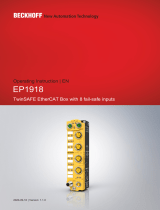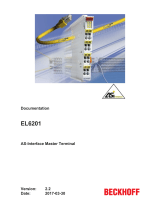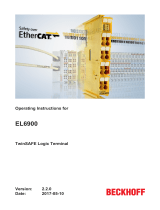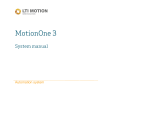Page is loading ...

Operation Manual for
EJ6910
TwinSAFE Logic Module
1.7.0
2017-11-15
Version:
Date:


Table of contents
EJ6910 3Version: 1.7.0
Table of contents
1 Foreword ....................................................................................................................................................5
1.1 Notes on the documentation........................................................................................................... 5
1.2 Safety instructions .......................................................................................................................... 6
1.2.1 Delivery state .....................................................................................................................6
1.2.2 Operator's obligation to exercise diligence ........................................................................6
1.2.3 Description of safety symbols ............................................................................................7
1.3 Documentation issue status............................................................................................................ 8
2 TwinSAFE System Description ................................................................................................................9
2.1 Extension of the Beckhoff I/O system with safety functions ........................................................... 9
2.2 Safety concept ................................................................................................................................ 9
2.3 EtherCAT plug-in module system (EJ) ......................................................................................... 10
3 Product description.................................................................................................................................11
3.1 EJ6910 - TwinSAFE logic module ................................................................................................ 11
3.2 Intended use ................................................................................................................................. 11
3.3 Safety parameters ........................................................................................................................ 12
3.4 Technical data .............................................................................................................................. 13
3.5 Dimensions ................................................................................................................................... 14
4 Operation..................................................................................................................................................15
4.1 Environmental conditions.............................................................................................................. 15
4.2 Installation..................................................................................................................................... 15
4.2.1 Safety instructions............................................................................................................15
4.2.2 Transport / storage...........................................................................................................15
4.2.3 Mechanical installation.....................................................................................................15
4.2.4 Electrical installation.........................................................................................................17
4.3 Configuration of the EJ6910 in TwinCAT...................................................................................... 17
4.3.1 Configuration requirements..............................................................................................17
4.3.2 Adding an EJ6910............................................................................................................17
4.3.3 Address setting on the TwinSAFE EJ modules with 1023 possible addresses ...............19
4.3.4 Creating a safety project in TwinCAT3 ...........................................................................20
4.3.5 Downloading the safety application .................................................................................47
4.3.6 Online Mode.....................................................................................................................50
4.3.7 New features in TC3.1 Build 4022 ...................................................................................55
4.4 Info Data ....................................................................................................................................... 71
4.4.1 Info data for the connection ............................................................................................71
4.4.2 Info data for function blocks .............................................................................................72
4.4.3 Info data for the TwinSAFE group....................................................................................73
4.4.4 Info data for the device ....................................................................................................74
4.5 Version history .............................................................................................................................. 75
4.6 User Administration ...................................................................................................................... 76
4.7 Backup/Restore ............................................................................................................................ 78
4.8 Export/import of the safety project ................................................................................................ 82
4.9 Tab Diag history............................................................................................................................ 84
4.10 TwinSAFE SC configuration ......................................................................................................... 85
4.11 Customizing / disabling TwinSAFE groups................................................................................... 89
4.12 Saving the analog group inputs persistently ................................................................................. 92
4.13 Project design limits of EL6910/EJ6910 ....................................................................................... 94
4.14 Sync-Manager Configuration ........................................................................................................ 94

Table of contents
EJ69104 Version: 1.7.0
4.15 TwinSAFE reaction times ............................................................................................................. 97
4.16 Diagnostics ................................................................................................................................... 99
4.16.1 Diagnostic LEDs...............................................................................................................99
4.16.2 Status LEDs ...................................................................................................................101
4.16.3 Diagnostic objects..........................................................................................................101
4.16.4 Cycle time of the safety project......................................................................................102
4.17 Maintenance ............................................................................................................................... 103
4.18 Service life .................................................................................................................................. 103
4.19 Decommissioning ....................................................................................................................... 104
5 Appendix ................................................................................................................................................105
5.1 Support and Service ................................................................................................................... 105
5.2 Certificates.................................................................................................................................. 106

Foreword
EJ6910 5Version: 1.7.0
1 Foreword
1.1 Notes on the documentation
Intended audience
This description is only intended for the use of trained specialists in control and automation engineering who
are familiar with the applicable national standards.
It is essential that the following notes and explanations are followed when installing and commissioning
these components.
The responsible staff must ensure that the application or use of the products described satisfy all the
requirements for safety, including all the relevant laws, regulations, guidelines and standards.
Origin of the document
This documentation was originally written in German. All other languages are derived from the German
original.
Currentness
Please check whether you are using the current and valid version of this document. The current version can
be downloaded from the Beckhoff homepage at http://www.beckhoff.com/english/download/twinsafe.htm.
In case of doubt, please contact Technical Support [}105].
Product features
Only the product features specified in the current user documentation are valid. Further information given on
the product pages of the Beckhoff homepage, in emails or in other publications is not authoritative.
Disclaimer
The documentation has been prepared with care. The products described are subject to cyclical revision. For
that reason the documentation is not in every case checked for consistency with performance data,
standards or other characteristics. We reserve the right to revise and change the documentation at any time
and without prior announcement. No claims for the modification of products that have already been supplied
may be made on the basis of the data, diagrams and descriptions in this documentation.
Trademarks
Beckhoff
®
, TwinCAT
®
, EtherCAT
®
, Safety over EtherCAT
®
, TwinSAFE
®
, XFC
®
and XTS
®
are registered
trademarks of and licensed by Beckhoff Automation GmbH.
Other designations used in this publication may be trademarks whose use by third parties for their own
purposes could violate the rights of the owners.
Patent Pending
The EtherCAT Technology is covered, including but not limited to the following patent applications and
patents: EP1590927, EP1789857, DE102004044764, DE102007017835 with corresponding applications or
registrations in various other countries.
The TwinCAT Technology is covered, including but not limited to the following patent applications and
patents: EP0851348, US6167425 with corresponding applications or registrations in various other countries.

Foreword
EJ69106 Version: 1.7.0
EtherCAT
®
is registered trademark and patented technology, licensed by Beckhoff Automation GmbH,
Germany
Copyright
© Beckhoff Automation GmbH & Co. KG, Germany.
The reproduction, distribution and utilization of this document as well as the communication of its contents to
others without express authorization are prohibited.
Offenders will be held liable for the payment of damages. All rights reserved in the event of the grant of a
patent, utility model or design.
Delivery conditions
In addition, the general delivery conditions of the company Beckhoff Automation GmbH & Co. KG apply.
1.2 Safety instructions
1.2.1 Delivery state
All the components are supplied in particular hardware and software configurations appropriate for the
application. Modifications to hardware or software configurations other than those described in the
documentation are not permitted, and nullify the liability of Beckhoff Automation GmbH & Co. KG.
1.2.2 Operator's obligation to exercise diligence
The operator must ensure that
• the TwinSAFE products are only used as intended (see chapter Product description);
• the TwinSAFE products are only operated in sound condition and in working order.
• the TwinSAFE products are operated only by suitably qualified and authorized personnel.
• the personnel is instructed regularly about relevant occupational safety and environmental protection
aspects, and is familiar with the operating instructions and in particular the safety instructions contained
herein.
• the operating instructions are in good condition and complete, and always available for reference at the
location where the TwinSAFE products are used.
• none of the safety and warning notes attached to the TwinSAFE products are removed, and all notes
remain legible.

Foreword
EJ6910 7Version: 1.7.0
1.2.3 Description of safety symbols
In these operating instructions the following symbols are used with an accompanying safety instruction or
note. The safety instructions must be read carefully and followed without fail!
DANGER
Serious risk of injury!
Failure to follow the safety instructions associated with this symbol directly endangers the
life and health of persons.
WARNING
Risk of injury!
Failure to follow the safety instructions associated with this symbol endangers the life and
health of persons.
CAUTION
Personal injuries!
Failure to follow the safety instructions associated with this symbol can lead to injuries to
persons.
Attention
Damage to the environment or devices
Failure to follow the instructions associated with this symbol can lead to damage to the en-
vironment or equipment.
Note
Tip or pointer
This symbol indicates information that contributes to better understanding.

Foreword
EJ69108 Version: 1.7.0
1.3 Documentation issue status
Version Comment
1.7.0 • Project design limits updated
• Description of new features in TwinCAT 3.1 Build 4022 added
• Description temperature measurement updated
• Intended use added
1.6.0 • Hint and flowchart to Backup/Restore added
• Note to the input and output process image added
• Description for Sync Manager configuration added
• TwinSAFE SC description updated
1.5.1 • Screenshots User Administration updated
• State and Diag of TwinSAFE group updated
• Technical data permissible air pressure expanded
1.5.0 • Screenshots updated
• Certificate updated
1.4.0 • Reference to standards updated
• Safety parameters updated
1.3.0 • Description of diagnosis object 0xFEA0 extended
1.2.0 • Description Backup/Restore expanded
• Description TwinSAFE SC expanded
1.1.0 • Chapters External connections, FB port properties, Parameterization of the alias device,
Variable mapping and Customizing updated
1.0.0 • Migration
0.6.0 • Preliminary (internal only)

TwinSAFE System Description
EJ6910 9Version: 1.7.0
2 TwinSAFE System Description
2.1 Extension of the Beckhoff I/O system with safety
functions
The TwinSAFE products from Beckhoff enable convenient expansion of the Beckhoff I/O system with safety
components, and integration of all the cabling for the safety circuit within the existing fieldbus cable. Safe
signals can be mixed with standard signals as required. The transfer of safety-related TwinSAFE telegrams
is handled by the standard controller. Maintenance is simplified significantly thanks to faster diagnosis and
simple replacement of components.
The following basic functionalities are included in the TwinSAFE components:
digital inputs (e.g. EL19xx, EP1908), digital outputs (e.g. EL29xx), drive components (e.g. AX5805) and logic
units (e.g. EL6900, EL6910). For a large number of applications, the complete safety sensor and actuator
technology can be wired on these components. The required logical link of the inputs and the outputs is
handled by the EL69xx. In addition to Boolean operations, the EL6910 now also enables analog operations.
2.2 Safety concept
TwinSAFE: Safety and I/O technology in one system
• Extension of the familiar Beckhoff I/O system with TwinSAFE components
• Safe and non-safe components can be combined as required
• Logical link of the I/Os in the EL69xx TwinSAFE logic terminal
• Suitable for applications up to SIL3 according to EN61508:2010 and Cat4, PLe according to
DINENISO13849-1:2016-06
• Safety-relevant networking of machines via bus systems
• In the event of an error, all TwinSAFE components always switch to the wattless and therefore safe
state
• No safety requirements for the higher-level standard TwinCAT system
Safety over EtherCAT protocol (FSoE)
• Transfer of safety-relevant data via any media (“genuine black channel”)
• TwinSAFE communication via fieldbus systems such as EtherCAT, Lightbus, PROFIBUS, PROFINET
or Ethernet
• IEC 61508:2010 SIL 3 compliant
• FSoE is IEC standard (IEC 61784-3-12) and ETG standard (ETG.5100)
Fail-safe principle (fail stop)
The basic rule for a safety system such as TwinSAFE is that failure of a part, a system component or the
overall system must never lead to a dangerous condition. The safe state is always the switched off and
wattless state.
CAUTION
Safe state
For all TwinSAFE components the safe state is always the switched-off, wattless state.

TwinSAFE System Description
EJ691010 Version: 1.7.0
2.3 EtherCAT plug-in module system (EJ)
Similar to the EtherCAT terminal system, a module strand consists of a Bus Coupler and any desired I/O
modules. In contrast to the EtherCAT Terminals, however, the EtherCAT plug-in modules have no spring-
loaded contacts, since the wiring level is outsourced: communication, signal distribution and the supply of
power to the modules takes place via plug connectors on the back side of the modules and the conductive
tracks of the signal distribution board.
The EtherCAT plug-in modules and the plug level for sensors and actuators can be placed flexibly on the
signal distribution board. Signal distribution boards can be user-developed or provided as custom solutions
by Beckhoff Automation GmbH & Co. KG.
Fig.1: EtherCAT plug-in module system (EJ)

Product description
EJ6910 11Version: 1.7.0
3 Product description
3.1 EJ6910 - TwinSAFE logic module
The TwinSAFE logic EJ module is the link unit between the TwinSAFE input and output modules.
The EJ6910 module meets the requirements of IEC61508:2010 SIL3 and DINENISO13849-1:2016-06
(Cat4, PLe).
Fig.2: EJ6910 - TwinSAFE logic module
3.2 Intended use
WARNING
Caution - Risk of injury!
TwinSAFE EJ modules may only be used for the purposes described below!
The TwinSAFE EJ modules expand the application range of the Beckhoff EtherCAT system by functions that
enable it to be used in the field of machine safety as well. The TwinSAFE EJ modules are designed for
machine safety functions and directly associated to industrial automation tasks. It is therefore approved only
for applications with a defined fail-safe state. This safe state is the wattless state.
The TwinSAFE EJ modules are suitable for operation on an EJ distribution board.
WARNING
System limits
The TÜV-SÜD certificate applies to the TwinSAFE EJ modules, the function blocks avail-
able in it, the documentation and the engineering tool. Approved engineering tools are
TwinCAT 3.1, TwinSAFE Loader and CODESYS Safety for EtherCAT Safety Module. Any
deviations from these procedures or tools, particularly externally generated xml files for
TwinSAFE import or externally generated automatic project creation procedures, are not
covered by the certificate.
WARNING
Power supply
An SELV/PELV power supply unit with a voltage limit of U
max
= 36V
DC
on the output side
must be used to supply power for the TwinSAFE EJ modules with 24V
DC
. Failure to ob-
serve this can result in a loss of safety.

Product description
EJ691012 Version: 1.7.0
WARNING
Commissioning test
Before the TwinSAFE EJ modules can be used for the safety task, the user must carry out
a commissioning test so that sensor and actuator wiring errors can be ruled out.
CAUTION
Note the Machinery Directive
The TwinSAFE EJ modules may only be used in machines according to the machinery di-
rective.
CAUTION
Ensure traceability
The buyer has to ensure the traceability of the device via the serial number.
3.3 Safety parameters
Key figures EJ6910
Lifetime [a] 20
Prooftest Interval [a] not required
1)
PFH
D
1.81E-09
%SIL3 of PFH
D
1.81%
PFD
avg
2.56E-05
%SIL3 of PFD
avg
2.56%
MTTF
d
high
DC high
Performance level PL e
Category 4
HFT 1
Element classification
2)
Type B
1. Special proof tests over the whole service life of the EtherCAT EJ6910 module are not required.
2. Classification according to IEC 61508-2:2010 (see chapters 7.4.4.1.2 and 7.4.4.1.3)
The EtherCAT EJ6910 module can be used for safety-related applications as defined in
IEC61508:2010 up to SIL3 and DINENISO13849-1:2016-06 up to Cat4, PLe.
For the calculation or estimation of the MTTF
d
value from the PFH
D
value, further information can be found in
the TwinSAFE application manual or in DINENISO13849-1:2016-06 Table K.1.

Product description
EJ6910 13Version: 1.7.0
3.4 Technical data
Product designation EJ6910
Number of inputs 0
Number of outputs 0
Status display 4 diagnostic LEDs
Minimum/maximum cycle time approx. 1 ms / according the project size
Error reaction time ≤ watchdog times
Watchdog time Min. 2ms, max. 60000ms
Input process image Dynamic, according to the TwinSAFE configuration in TwinCAT3
Output process image Dynamic, according to the TwinSAFE configuration in TwinCAT3
Supply voltage (SELV/PELV) 24V
DC
(–15%/+20%)
Current consumption approx. 222 mA
Power dissipation of the terminal typically 1 W
Dimensions (W x H x D) 12mm x 66mm x 55mm
Weight approx. 27 g
Permissible ambient temperature (operation) -25°C to +55°C
Permissible ambient temperature (transport/storage) -40°C to +70°C
Permissible air humidity 5% to 95%, non-condensing
Permissible air pressure (operation/storage/transport) 750hPa to 1100hPa
(this corresponds to a height of approx. -690m to 2450m over
sea level assuming an international standard atmosphere)
Climate category according to EN 60721-3-3 3K3
(the deviation from 3K3 is possible only with optimal environmen-
tal conditions and also applies only to the technical data which
are specified differently in this documentation)
Permissible level of contamination according to EN60664-1
level of contamination 2 (comply with the chapter Maintenance
[}103])
Impermissible operating conditions TwinSAFE EJ modules must not be used under the following
conditions:
• under the influence of ionizing radiation (that exceeds the
level of the natural environmental radiation)
• in corrosive environments
• in an environment that leads to unacceptable soiling of
the Bus Terminal
Vibration/shock resistance conforms to EN 60068-2-6 / EN 60068-2-27
EMC immunity/emission conforms to EN 61000-6-2 / EN 61000-6-4
Shocks 15 g with pulse duration 11 ms in all three axes
Protection class IP20
Permitted operating environment control cabinet or terminal box with minimum protection class
IP54 according to IEC 60529
Permissible installation position
see chapter Installation position and minimum distances [}16]
Approvals CE, TÜV SÜD

Product description
EJ691014 Version: 1.7.0
3.5 Dimensions
Fig.3: EJ6910 - dimensions
Width: 12 mm
Height: 66 mm
Depth: 55 mm

Operation
EJ6910 15Version: 1.7.0
4 Operation
4.1 Environmental conditions
Please ensure that the TwinSAFE components are only transported, stored and operated under the specified
conditions (see technical data)!
WARNING
Risk of injury!
The TwinSAFE components must not be used under the following operating conditions.
• under the influence of ionizing radiation (that exceeds the level of the natural environ-
mental radiation)
• in corrosive environments
• in an environment that leads to unacceptable soiling of the TwinSAFE component
Attention
Electromagnetic compatibility
The TwinSAFE components comply with the current standards on electromagnetic compat-
ibility with regard to spurious radiation and immunity to interference in particular.
However, in cases where devices such as mobile phones, radio equipment, transmitters or
high-frequency systems that exceed the interference emissions limits specified in the stan-
dards are operated near TwinSAFE components, the function of the TwinSAFE compo-
nents may be impaired.
4.2 Installation
4.2.1 Safety instructions
Before installing and commissioning the TwinSAFE components please read the safety instructions in the
foreword of this documentation.
4.2.2 Transport / storage
Use the original packaging in which the components were delivered for transporting and storing the
TwinSAFE components.
CAUTION
Note the specified environmental conditions
Please ensure that the digital TwinSAFE components are only transported and stored un-
der the specified environmental conditions (see technical data).
4.2.3 Mechanical installation
DANGER
Risk of injury!
Bring the bus system into a safe, de-energized state before starting installation, disassem-
bly or wiring of the devices!
4.2.3.1 Control cabinet / terminal box
The TwinSAFE EJ modules must be installed in a control cabinet or terminal box with IP54 protection class
according to IEC60529 as a minimum.

Operation
EJ691016 Version: 1.7.0
4.2.3.2 Installation position and minimum distances
For the prescribed installation position the backplane is mounted horizontally (EJ plug connector vertical),
and the connection surfaces of the EJ modules face forward (see diagram below). The EJ modules are
ventilated from below, which enables optimum cooling of the electronics through convection. The direction
indication “down” corresponds to the direction of positive acceleration due to gravity.
Fig.4: Installation position and minimum distances
In order to ensure optimum convection cooling, the distances to neighboring devices and to control cabinet
walls must not be smaller than those shown in the diagram.
4.2.3.3 Temperature measurement
The temperature measurement consists of an EJ1100 EtherCAT coupler, to which EJ modules are attached,
based on the typical distribution of digital and analog signal types at a machine. On the EJ6910 a safety
project is active, which reads safe inputs and enables safe outputs during the measurement.
Note
External heat sources / radiant heat / impaired convection
The maximum permissible ambient temperature of 55°C was checked with the sample con-
figuration described above. Impaired convection; an unfavorable location near heat sources
or an unfavorable configuration of the EtherCAT EJ modules may result in overheating of
the modules.
The key parameter is always the maximum permitted internally measured temperature of
110°C, above which the TwinSAFE components switch to safe state and report an error.
The internal temperature can be read from the TwinSAFE components via CoE.

Operation
EJ6910 17Version: 1.7.0
4.2.4 Electrical installation
DANGER
Risk of injury!
Bring the bus system into a safe, de-energized state before starting installation, disassem-
bly or wiring of the devices!
4.2.4.1 Connections between EJ modules
The electrical connections between the EJ Bus Coupler and EJ modules are realized automatically by
plugging the components into the EJ backplane.
Note
Note the maximum E-bus current!
Observe the maximum current that your EJ Bus Coupler can supply to the E-bus! Use the
EJ9400 power supply module if the current consumption of your modules exceeds the max-
imum current your EJ Bus Coupler can provide.
4.2.4.2 Overvoltage protection
If protection against overvoltage is necessary in your plant, provide a surge filter for the voltage supply to the
Bus Terminal blocks and the TwinSAFE EJ modules.
4.3 Configuration of the EJ6910 in TwinCAT
CAUTION
Do not change CoE objects!
Do not change any of the CoE objects in the TwinSAFE EJ modules. Changes in the CoE
objects (e.g. via the System Manager or TwinCAT3) permanently switch the TwinSAFE EJ
modules to the Fail-Stop state or lead to unexpected behavior of the modules!
4.3.1 Configuration requirements
Configuration of the TwinCAT Safety PLC requires TwinCAT automation software version3.1 build4020 or
higher. The current version is available for download from the Beckhoff website at www.beckhoff.de.
Note
TwinCAT support
The TwinCAT Safety PLC cannot be used under TwinCAT 2.
4.3.2 Adding an EJ6910
The EJ6910 TwinSAFE logic module is added in the same way as any other EtherCAT device. Open Safety
Terminals in the list, then select the EJ6910 module.

Operation
EJ691018 Version: 1.7.0
Fig.5: TwinCAT - adding an EJ6910
Note
Size of the process image
The process image of the EJ6910 TwinSAFE logic module is adjusted dynamically, accord-
ing to TwinSAFE configuration created in TwinCAT3.

Operation
EJ6910 19Version: 1.7.0
4.3.3 Address setting on the TwinSAFE EJ modules with 1023
possible addresses
Fig.6: Address setting on TwinSAFE EJ modules with 1023 possible addresses
Use the 10-way DIP switch on the left of a TwinSAFE EJ module to set the TwinSAFE address of the
module. TwinSAFE addresses between 1 and 1023 are available.
DIP switch Address
1 2 3 4 5 6 7 8 9 10
ON OFF OFF OFF OFF OFF OFF OFF OFF OFF 1
OFF ON OFF OFF OFF OFF OFF OFF OFF OFF 2
ON ON OFF OFF OFF OFF OFF OFF OFF OFF 3
OFF OFF ON OFF OFF OFF OFF OFF OFF OFF 4
ON OFF ON OFF OFF OFF OFF OFF OFF OFF 5
OFF ON ON OFF OFF OFF OFF OFF OFF OFF 6
ON ON ON OFF OFF OFF OFF OFF OFF OFF 7
... ... ... ... ... ... ... ... ... ... ...
ON ON ON ON ON ON ON ON ON ON 1023
WARNING
TwinSAFE address
Each TwinSAFE address may only be used once within a network/ a configuration!
The address 0 is not a valid TwinSAFE address!

Operation
EJ691020 Version: 1.7.0
4.3.4 Creating a safety project in TwinCAT3
4.3.4.1 Add new item
In TwinCAT 3 a new project can be created via AddNewItem… in the context menu of the Safety node.
Fig.7: Creating a safety project - Add New Item
The project name and the directory can be freely selected.
Fig.8: Creating a safety project - project name and directory
4.3.4.2 TwinCAT Safety Project Wizard
In the TwinCATSafetyProject wizard you can then select the target system, the programming language, the
author and the internal project name. Select the setting HardwareSafetyPLC as the target system and the
graphical editor as the programming language. The author and the internal project name can be freely
selected by the user.
/












